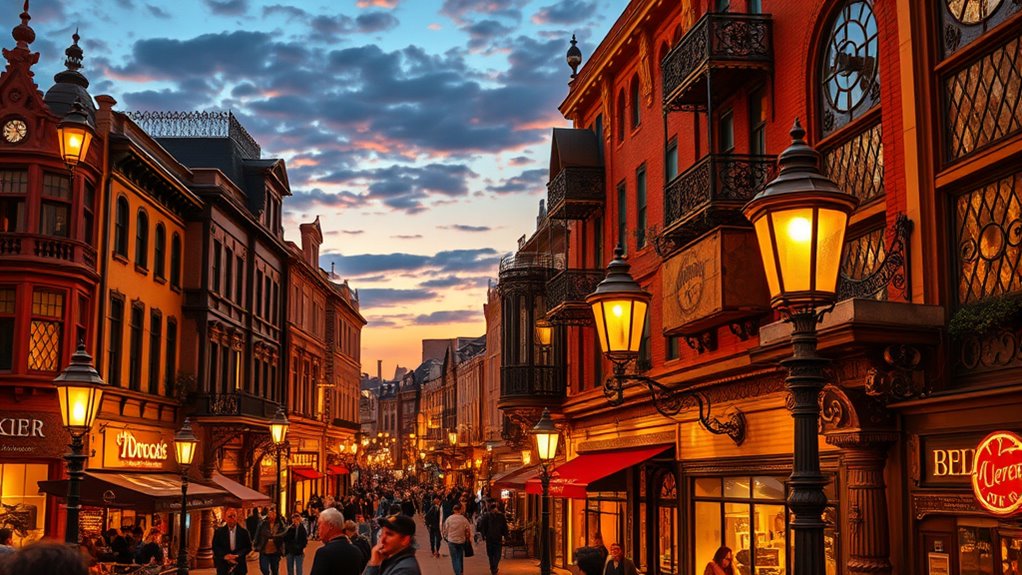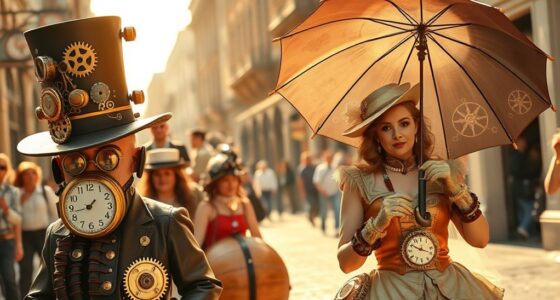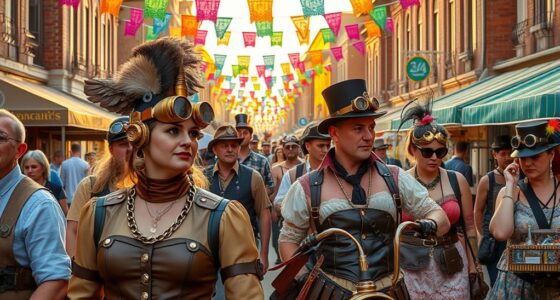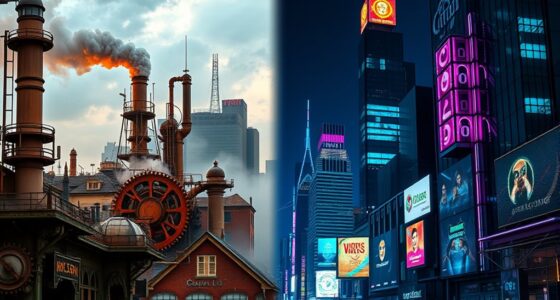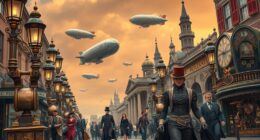Gaslamp fantasy and steampunk both draw from Victorian aesthetics but focus on different themes. Gaslamp fantasy immerses you in magical worlds, emphasizing mysticism, enchantment, and supernatural elements, with Victorian fashion and architecture serving as a backdrop. Steampunk, on the other hand, highlights inventive machinery, gears, and steam-powered technology, exploring societal change and engineering mastery. If you want to understand how these genres shape their stories and visuals, exploring their contrasts reveals fascinating worlds.
Key Takeaways
- Gaslamp fantasy emphasizes magic, mystical creatures, and enchanted worlds, while steampunk focuses on steam-powered machinery and mechanical inventions.
- Visual styles differ: gaslamp fantasy features ornate Victorian architecture and fashion, whereas steampunk highlights gears, brass, and mechanical devices.
- Narrative themes: gaslamp fantasy centers on wonder and mysticism; steampunk explores technological innovation and societal change.
- Technology in gaslamp fantasy is secondary and enchanted; in steampunk, machinery and engineering are primary elements.
- Both genres draw on Victorian aesthetics but differ in thematic focus—magic versus machinery.
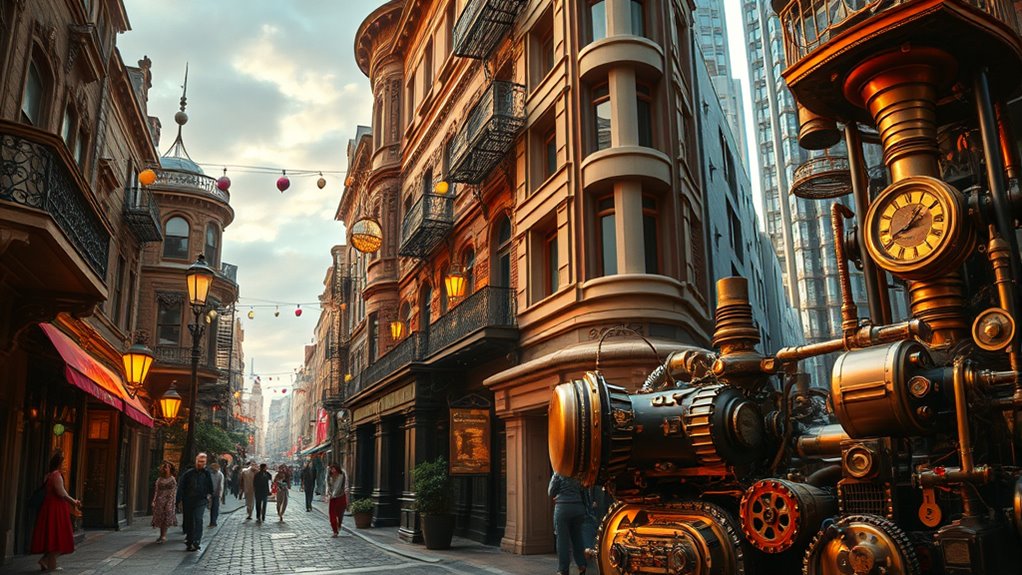
Have you ever wondered what distinguishes gaslamp fantasy from steampunk? While they often share a similar Victorian-inspired aesthetic, the key differences lie in their aesthetic influences and their approach to technological advancements. Gaslamp fantasy tends to draw heavily from classic fantasy elements, with a focus on magic, mythical creatures, and supernatural phenomena woven seamlessly into a Victorian-era setting. Its aesthetic influences come from Gothic literature, fairy tales, and romanticized visions of the past. The style emphasizes ornate architecture, Victorian fashion, and an overall sense of mystery and wonder, creating a fantastical ambiance that transports you to a time where magic and mysticism coexist with the era’s elegance. Technological advancements in gaslamp fantasy are usually secondary, serving as a backdrop to the magic rather than a dominant feature. When technology appears, it often takes the form of enchanted objects or mystical devices that enhance the fantastical narrative, rather than the mechanical innovations seen in steampunk.
In contrast, steampunk is rooted in a fascination with technological progress and industrial innovation. Its aesthetic influences derive from the Victorian era’s burgeoning industrial revolution, with a focus on steam-powered machinery, clockwork mechanisms, and mechanical inventions. The visual style of steampunk is characterized by gears, brass fittings, goggles, and intricate mechanical contraptions that highlight humanity’s mastery over technology. The genre’s emphasis on technological advancements is central; it explores how steam-driven inventions could transform society, often imagining alternative histories where technology develops along different paths. The focus is on the ingenuity of engineering, often blending Victorian fashion with futuristic or fantastical modifications. Steampunk enthusiasts celebrate the craftsmanship of mechanical devices, and stories frequently revolve around inventors, explorers, and engineers pushing the boundaries of what’s possible with steam-powered tech.
While both genres evoke Victorian aesthetics, gaslamp fantasy leans into the domain of the magical and supernatural, often creating worlds where fantasy and mysticism dominate the landscape. Steampunk, however, is driven by the marvels of human ingenuity and technological innovation, emphasizing mechanical complexity and industrial aesthetics. Their differences are clear: gaslamp fantasy immerses you in enchanted worlds where magic is real, with technology playing a supporting role, whereas steampunk invites you to explore a mechanically intricate universe where technological progress shapes society and adventure. Understanding these distinctions helps you appreciate each genre’s unique charm and the way they reimagine history through contrasting lenses of magic and machinery.
Frequently Asked Questions
How Do Gaslamp Fantasy and Steampunk Influence Modern Fashion Trends?
You’re likely to notice that gaslamp fantasy and steampunk influence modern fashion through Victorian fashion-inspired clothing, like corsets, waistcoats, and lace details. They also inspire futuristic accessories, such as goggles and mechanical jewelry. These genres encourage a blend of historical elegance with innovative, imaginative elements, making your wardrobe stand out. Whether at costume events or everyday wear, embracing these styles helps you express creativity while paying homage to retro-futuristic aesthetics.
Are There Specific Authors Known for Each Genre?
Imagine stepping into a Victorian-inspired world with a touch of modern flair—authors like Victoria Conway and Gail Carriger are genre pioneers in gaslamp fantasy, gaining prominence for their imaginative stories. For steampunk, authors such as K.W. Jeter and Cherie Priest stand out as genre pioneers, shaping its evolution. You’ll find these writers are celebrated for their vivid world-building and influence, making them essential to understanding each genre’s unique appeal.
Can These Genres Overlap in Films and Television?
You’ll find that films and TV shows often blend the dichotomy of aesthetics from gaslamp fantasy and steampunk, creating engaging genre blending possibilities. This overlap allows creators to incorporate Victorian-inspired settings, fantastical elements, and retro-futuristic technology seamlessly. Shows like “The Nevers” and “Carnival Row” exemplify how these genres can coexist, offering viewers rich worlds that mix magical realism with industrial innovation, enhancing storytelling with visual and thematic depth.
What Are the Key Cultural Influences Behind Each Genre?
You’ll find that Victorian aesthetics heavily influence gaslamp fantasy, emphasizing elegance, magic, and whimsy rooted in 19th-century sensibilities. Steampunk, on the other hand, is shaped by the Industrial Revolution, showcasing technological innovation, machinery, and a gritty, mechanical vibe. Both genres reflect their cultural influences, with gaslamp fantasy embracing fantasy and mysticism, while steampunk celebrates technological progress and its social implications. These roots help you understand their unique atmospheres.
How Do These Genres Impact Gaming and Tabletop Role-Playing Communities?
You find that both genres markedly impact gaming and tabletop communities by inspiring unique role playing mechanics and fostering community engagement. Gaslamp fantasy often emphasizes magical intrigue and Victorian aesthetics, encouraging immersive storytelling. Steampunk, with its focus on industrial innovation, promotes creative problem-solving and collaborative gameplay. These genres inspire players to explore new worlds, deepen social bonds, and develop inventive strategies, enriching their overall gaming experience and strengthening community ties.
Conclusion
So, now that you’ve explored both genres, you see how gaslamp fantasy weaves magic into Victorian settings, while steampunk thrives on gritty innovation and machinery. Which world feels more like your own imagination’s playground? Whether you prefer enchanting spells or intricate gears, both genres invite you to dream beyond the ordinary. Isn’t it exciting to imagine stepping into these alternate realities and shaping your own adventure? After all, isn’t that what great stories are all about?
